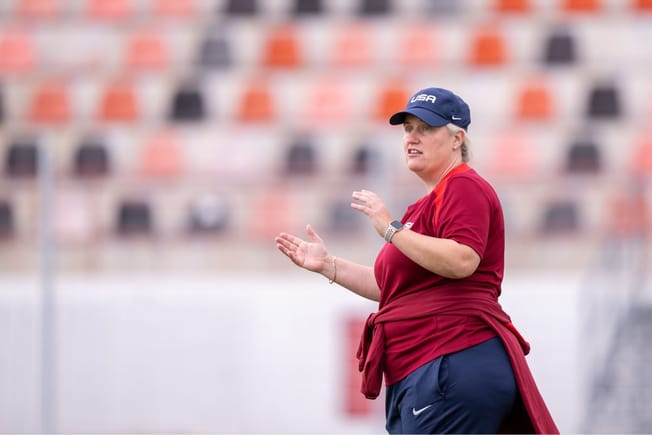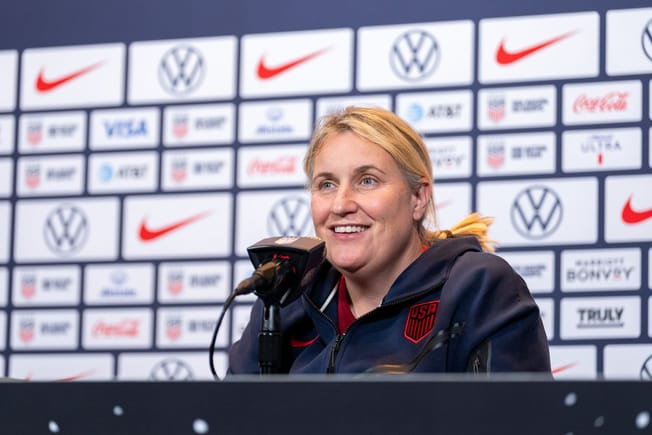Quick Hits:
- Poor attacking decisions and positioning have plagued Vlatko Andonovski’s team for years now
- With the World Cup kicking off this summer, the United States must address their attacking issues
Teams are catching up — or have already caught up — to the United States women’s national team.
You only need to watch a few minutes of film on Germany, England, France, or a handful of other European nations to find that out. Those teams have arrived. And they showed at the Olympics in 2021 and in a set of friendlies against the United States in 2022 that they’re not going anywhere. The competition for this year’s World Cup trophy will be stiffer than ever before.
The biggest thing standing between the United States and a World Cup three-peat, though, isn’t one of the European countries that beat them at the end of last year.
No, the U.S.’s biggest obstacle ahead of this summer’s tournament is themselves.
It’s February, 2021. The United States is in Orlando, facing off against Canada in a SheBelieves Cup game. In a few months, the team will be in hot pursuit of a gold medal in the Olympics. This game is about getting ready. It’s about fine-tuning. It’s about firing as many crosses into the box as humanly possible before the referee blows the final whistle.
Wait, that can’t be right? Let me check my notes. No, that’s right. The USWNT fired off 42 crosses against Canada that day.
42. Crosses.
It’s pretty much impossible to imagine a more inefficient attacking gameplan than one involving that many crosses.
Crosses into the box have their place — and some are more valuable than others — but there’s plenty of research out there showing they don’t lead to goals as often as other kinds of passes. One study performed by American Soccer Analysis found that 2.5 goals are scored per 100 crosses, a number that pales in comparison to 6.4 goals scored per 100 cutbacks, 4.5 goals per 100 progressive passes, and a whopping 13.2 goals per 100 through balls.
The USWNT, for all of their game-breaking talent and global superstars, don’t know what to do when they have the ball for more than a few seconds. And that’s a big, big problem.
While the U.S. eventually found a way through against Canada, from a cross, true to form, brutally inefficient possession play has been a theme under manager Vlatko Andonvoski.
Now the U.S. know exactly what to do when they have the ball and plenty of green grass in front of them. Sophia Smith and Mallory Swanson (née Pugh), among others, are lethal on the break. The U.S. want to run at recovering defenses all the time because they know that when they do, they’re going to rip you apart.
Standout stuff by @sunshine_sully in the midfield and a bit of @MalPugh magic puts us in front ✨🇺🇸⚽️ pic.twitter.com/qQvxdo7j7E
— U.S. Women's National Soccer Team (@USWNT) November 13, 2022
But what happens when the U.S. have to create space for themselves? Well, that’s when the USWNT start to fall apart.
“Breaking down a low block is not a secret. There are six, seven, eight steps that teams take,” Andonovski said last year before listing the first strategies that came to his mind. “Progression in the wide channel, combination in front of the box, runs behind the backline, early crosses, crosses on the side, or crosses from the halfspace.”
I love that Andonovski gave an answer to a tactical question. But it’s strange that the U.S. manager called out wide attacking play and three different kinds of crosses instead of touching on cutbacks and through balls. Andonovski specifically called out an inefficient set of attacking options over a set of more efficient ones.
Now, reading too much into press conference answers that are composed on the fly isn’t the absolute best way to analyze a team. So let’s look at the tape, too.
Making bad choices
Plenty of things have changed for the U.S. over the last few years.
A group of young, talented attackers is seemingly taking on more responsibility for the United States every game. There are new faces in the midfield and across the backline, too. One thing that hasn’t changed much, though, is how the USWNT operate when they have the ball.
Despite having a collection of the world’s most skillful players, the U.S. seem to deliberately avoid using those players to their advantage.
Here’s a look at the USWNT skipping out on a chance to use their talent advantage in that Canada game in 2021.
The ball comes out wide to Midge Purce while the United States are in possession. As Purce receives the ball, Lynn Williams, the right winger, changes the direction of her run. Instead of moving wide to support her teammate and try to pass or dribble through Canada’s backline, Williams resigns herself to a cross. She knows the drill. Move the ball wide, get into the box.
— _ (@21LBRB) January 3, 2023
The cross never comes because Purce miscontrolled her first touch. But make no mistake, there’s no intent to combine or create space in this clip. There’s no belief that the U.S. has the better players. There’s only one objective: pump the ball into the box or get fouled trying.
Here’s a nearly identical sequence, just with a different cast of characters in a different stadium.
In the first half against Spain in October, 2022, the ball comes to Hailie Mace on the right. As Mace receives the ball, Trinity Rodman, the right winger, changes the direction of her run — does this sound familiar? Rodman doesn’t support Mace. She knows the drill, too. Move the ball wide, get into the box.
— _ (@21LBRB) January 4, 2023
Unsurprisingly, Mace’s cross flies harmlessly into the hands of the opposing goalkeeper.
That decision in the final third, as we touched on earlier, is usually the wrong one. You’re better off getting to the endline and cutting the ball back to a runner in the box than you are crossing the ball into the box from out wide. Despite both the numbers and straightforward logic, the USWNT continue to move and play in a way that the world’s smartest teams ditched years ago.
It’s tough to watch some of these sequences, not because hitting crosses into the box is always bad. But because the U.S. minimize the number of touches that their most influential players get on the ball. They end up hoping that the opposition makes a mistake instead of truly using their attacking firepower to force that mistake.
Poor positioning
The USWNT’s insistence on crossing isn’t the only thing minimizing the touches that their best conductors get on the ball: their own positioning does it, too.
In possession, the U.S.’s central midfielders often pull wide to become pseudo-wingers in the attack. Lindsey Horan, who usually starts on the left side of central midfield, and Rose Lavelle, her counterpart on the right, rotate all the way out to the wings.
Now, soccer is fluid. Players rotate in and out of positions so often that the shorthand ways we refer to formations — “4-3-3”, “4-2-3-1”, and so on — don’t even come close to capturing how a team looks when they have the ball. A fullback might become a winger for a while. A striker might become a midfielder. A midfielder might become a forward or a defender.
Everyone is moving all the time, and so often that movement is what unbalances defenders, forces mistakes, and creates goals. But for the U.S., moving their central midfielders out of, um, the middle of the field doesn’t help.
It hurts.
That wide rotation takes Horan and Lavelle away from the most important spots on the field.
Forward passes are more common in the halfspaces and more valuable in the middle of the field than they are out wide. Plus, the passing angles that are most likely to be part of goal-scoring possessions come from the middle of the field, not from the wings. There’s a reason why you rarely see the world’s most creative midfielders rotate all the way out to the wing: there’s more to be gained in the middle than there is out wide.
And yet, the USWNT’s central midfielders regularly make a point of moving all the way out wide. If you’re Andonovski, why not ask your midfielders to stay inside, get on the ball, and pull apart the opposing defense?
Even if you’re not going to really play through your central midfielders, having them in the middle helps prevent easy counter attacks for your opponents.
Just look at this clip from the USWNT’s most recent game, the second of their clashes with Germany in November, 2022. Horan rotates out wide to give left back Emily Fox the halfspace. Becky Sauerbrunn plays the ball forward to Horan out wide, but Horan is too slow to react and gets pushed off the ball. A few seconds later and Germany’s most dangerous attacker has the ball at her feet inside the U.S.’s box.
— _ (@21LBRB) January 4, 2023
Between Horan’s wide positioning and undisciplined starting spots from the rest of the U.S.’s outfield players, there wasn’t any cover for defensive midfielder Andi Sullivan. They simply didn’t have enough bodies in the middle to deal with Germany’s counter attack.
Moving Horan, Lavelle, or whoever starts at the No. 8 for the USWNT back into the middle isn’t guaranteed protection from counter attacks. But it sure could help cut down on moments like the one up above. And it would help the attack start to flow, too.
The beautiful thing about the U.S. women’s national team is that even with their flaws, they’re still one of the best teams in the world.
With all of their talent, they still find some good looks over the course of 90 minutes. They still do amazing things on the field. And they’re still in contention to win absolutely every game they play. But why settle for less? Why settle for some good looks when you could have a bunch of good looks?
There’s so much room for the U.S. to get better, which should be a scary thought for their opponents. They can turn more attacks into goals, more wins into dominant displays, and more World Cups into victory parades.
It just has to start with making better choices on and off the ball – and getting out of their own way.







Comments